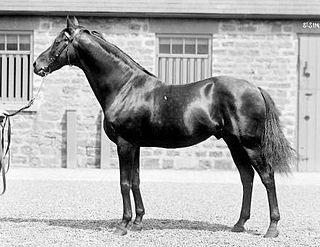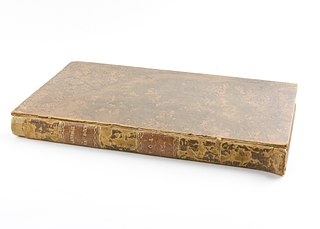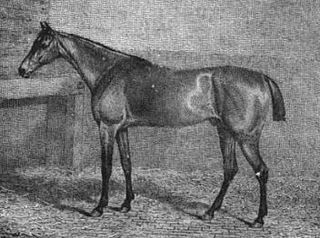Related Research Articles

Northern Dancer was a Thoroughbred that, in 1964, became the first Canadian-bred horse to win the Kentucky Derby. After being retired from racing, he became one of the most successful sires of the 20th century. He is considered a Canadian icon and was inducted into the Canadian Sports Hall of Fame in 1965. Induction into the Racing Hall of Fame in both Canada and the United States followed in 1976. As a competitor, The Blood-Horse ranked him as one of the top 100 U.S. Thoroughbred racehorses of the 20th century. As a sire of sires, his influence on the breed is still felt worldwide.

Nearco was an Italian-bred Thoroughbred racehorse described by Thoroughbred Heritage as "one of the greatest racehorses of the Twentieth Century" and "one of the most important sires of the century." He was unbeaten, winning 14 races at distances from 1000m to 3000m, including the Derby Italiano and Grand Prix de Paris. He was then sold for a record amount to Martin H. Benson and stood stud in England, where he became the patriarch of several of the most dominant sire lines in Thoroughbred history.

Potoooooooo or variations of Pot-8-Os was an 18th-century thoroughbred racehorse who won over 30 races and defeated some of the greatest racehorses of his time. He went on to be an important sire, whose leading runners included Epsom Derby winners Waxy, Champion, and Tyrant. He is best known for the unusual spelling of his name, pronounced 'Potatoes'.

Pocahontas (1837–1870) was an English Thoroughbred racehorse and the dam of three sires who had a great influence on the breed. Although mares are not generally considered to be as influential as sires, Thoroughbred Heritage refers to Pocahontas as "one of the most influential Thoroughbreds of all time, male or female."

St. Simon was an undefeated British Thoroughbred racehorse and one of the most successful sires in the history of the Thoroughbred. In May 1886 The Sporting Times' carried out a poll of one hundred experts to create a ranking of the best British racehorses of the 19th century. St. Simon was ranked fourth, having been placed in the top ten by 53 of the contributors.
Nearctic was a Canadian-bred Hall of Fame Thoroughbred racehorse.
Peeping Fawn is a Champion Irish-trained Thoroughbred racehorse. Unraced as a two-year-old, it took her four tries to break her maiden at age three. Her form then rapidly improved, reflected by a third-place finish in the Irish 1,000 Guineas and a second in The Oaks, followed by four consecutive Group One wins – the Pretty Polly, Irish Oaks, Nassau and Yorkshire Oaks. She was named the Cartier Champion Three-year-old Filly of 2007.

Thoroughbred breeding theories are used by horse breeders in an attempt to arrange matings that produce progeny successful in horse racing. Bloodstock experts also rely on these theories when purchasing young horses or breeding stock. A basic understanding of these theories can also help the racing public understand a horse's theoretical genetic potential. The breeding theories stem from the belief that careful analysis of bloodlines can lend predictability to breeding outcomes. A well-designed mating increases the probability of the offspring's success, although many other factors also come into play.
Natalma was an American-bred Thoroughbred racehorse best known as the dam (mother) of the most important sire, and sire of sires, of the late 20th Century, Northern Dancer. She also established a highly influential female family, which has produced other leading sires Machiavellian and Danehill, plus numerous other stakes winners. Natalma was inducted into the Canadian Horse Racing Hall of Fame in 2007.

Assert was an Irish Thoroughbred racehorse and sire. As a two-year-old he was beaten by Golden Fleece on his debut but went on to win the Beresford Stakes. In the following year he won four Group One races: the French Derby, Irish Derby, Benson & Hedges Gold Cup and Joe McGrath Memorial Stakes. He was rated the best middle-distance horse in Europe in 1982 by Timeform. He was retired to stud at the end of his three-year-old season and became a successful sire of winners.

Crucifix (1837–1857) was an undefeated, Classic Race winning, British-bred Thoroughbred racemare. She was also the dam of three sires who had a great influence on the breed.

Blucher was a British Thoroughbred racehorse and sire named after the Prussian General Gebhard Leberecht von Blücher, one of the most successful commanders of the Napoleonic Wars, but his name was invariably spelt without the umlaut.

Cobweb (1821–1848) was an undefeated British Thoroughbred racehorse and who won two British Classic Races as a three-year-old and went on to become a highly successful broodmare. Cobweb's racing career consisted of three competitive races in the early part of 1824. After winning on her debut she claimed a second prize when her opponents were withdrawn by their owners. She then won the 1000 Guineas at Newmarket Racecourse and the Oaks Stakes at Epsom Downs Racecourse before being retired to stud.

Sweetbriar was a British Thoroughbred racehorse. He won all eight of the races he contested, including a match race against Craven Stakes winner Firetail. He later became a successful stallion, with his progeny including Epsom Derby winner Assassin.
What a Pleasure (1965-1983) was a Thoroughbred stallion bred at Claiborne Farm in Kentucky for the Wheatley Stables of Glady Phipps. Sired by the leading stallion Bold Ruler, and out of a Mahmoud mare Grey Flight, he excelled on the track and in his stud career. Like his sire, he would go on to become a leading North American stallion; producing Eclipse Award winners and Kentucky Derby winners.
Long Look was an American-bred, Irish-trained Thoroughbred racehorse and broodmare. After showing promising form as a juvenile in 1964 she developed into a top-class performer in the following year. She recorded her biggest win in the Epsom Oaks as well as finishing second in the Irish Oaks, third in the Prix Vermeille and fourth in the 1000 Guineas. As a broodmare she produced three foals, all of which won races.
Steady Aim was a British Thoroughbred racehorse and broodmare best known for her win in the 1946 Epsom Oaks. After winning one minor race as a juvenile she showed improved form in the following spring to finish third in a very competitive trial race Hurst Park and then came home an easy winner of the Oaks in June. Her racing career was ended by injury soon afterwards. As a broodmare she produced several good winners and was the female-line ancestor of the leading stallion Danzig.
Electra was a British Thoroughbred racehorse and broodmare. A a two-year-old she showed considerable promise as she won four time from eight starts and finished second on three occasions. In the following year she won the 1000 Guineas and the Park Hill Stakes as well as finishing second in the Newmarket Stakes, Coronation Stakes and Free Handicap. She appeared to be most unlucky when running unplaced in the Epsom Oaks. She failed to win as a four-year-old and was retired from racing but later became a very successful broodmare.
Australian was a British-bred Thoroughbred racehorse and sire. He was exported to the United States where he had modest success as a racehorse but became a very successful and influential breeding stallion.
Miss Disco (1944–1974) was an American Thoroughbred racemare that won important sprint events against colts during her racing career but who secured her place in history when, as a broodmare at Claiborne Farm, she was bred to Nasrullah and produced the very influential National Champion and Hall of Fame sire Bold Ruler.
References
- 1 2 3 "Lady Angela's Pedigree". Equineline. Retrieved 24 June 2017.
- ↑ Avalyn Hunter. "Nearco (horse)". American Classic Pedigrees. Retrieved 24 June 2017.
- 1 2 3 Avalyn Hunter. "Nearctic (horse)". American Classic Pedigrees. Retrieved 24 June 2017.
- 1 2 3 "Thoroughbred Bloodlines - Pretty Polly - Family 14-c". www.bloodlines.net. Retrieved 24 June 2017.
- 1 2 3 4 "Lady Angela | Canadian Horse Racing Hall of Fame" . Retrieved 24 June 2017.
- ↑ "Pedigree of Lady Angela". pedigreequery.com. Retrieved 24 June 2017.
- ↑ "Nearctic's pedigree with nicking stats". Equineline. Retrieved 24 June 2017.
- 1 2 3 "Lady Angela Offspring". www.pedigreequery.com. Retrieved 24 June 2017.
- ↑ "Triumph and Tribulation". Summerhill Stud. Retrieved 24 June 2017.
- ↑ Pappas, Stephanie. "Thoroughbred Racehorses Get Speed from Just a Few Ancestors". Live Science. Retrieved 24 June 2017.
- ↑ "Requests to Designate Certain Buildings... pursuant to the Ontario Heritage Act" (PDF). app.oshawa.ca. Retrieved 24 June 2017.